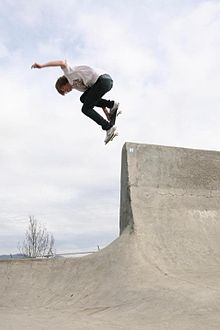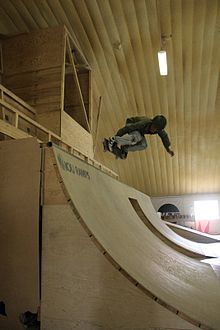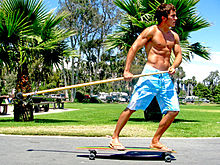
Skateboarding
Did you know...
SOS Children have produced a selection of wikipedia articles for schools since 2005. Do you want to know about sponsoring? See www.sponsorachild.org.uk
Skateboarding is an action sport which involves riding and performing tricks using a skateboard. Skateboarding can also be considered a recreational activity, an art form, a job, or a method of transportation. Skateboarding has been shaped and influenced by many skateboarders throughout the years. A 2002 report found that there were 18.5 million skateboarders in the world. 85% of skateboarders polled who had used a board in the last year were under the age of 18, and 74% were male.
Skateboarding is relatively modern. Since the 1970s, skateparks have been constructed specifically for use by skateboarders, bikers and inline skaters.
History
1940s–1960s

Skateboarding was probably born sometime in the late 1940s or early 1950s when surfers in California wanted something to surf when the waves were flat. No one knows who made the first board; it seems that several people came up with similar ideas at around the same time. These first skateboarders started with wooden boxes or boards with roller skate wheels attached to the bottom. The boxes turned into planks, and eventually companies were producing decks of pressed layers of wood — similar to the skateboard decks of today. During this time, skateboarding was seen as something to do for fun besides surfing, and was therefore often called "sidewalk surfing".
The first manufactured skateboards were ordered by a Los Angeles, California surf shop, meant to be used by surfers in their downtime. The shop owner, Bill Richard, made a deal with the Chicago Roller Skate Company to produce sets of skate wheels, which they attached to square wooden boards. Accordingly, skateboarding was originally denoted "sidewalk surfing" and early skaters emulated surfing style and maneuvers. Crate scooters preceded skateboards, and were born of a similar concept, with the exception of having a wooden crate attached to the nose (front of the board), which formed rudimentary handlebars.
A number of surfing manufacturers such as Makaha started building skateboards that resembled small surfboards, and assembled teams to promote their products. The popularity of skateboarding at this time spawned a national magazine, Skateboarder Magazine, and the 1965 international championships were broadcast on national television. The growth of the sport during this period can also be seen in sales figures for Makaha, which quoted $10 million worth of board sales between 1963 and 1965 (Weyland, 2002:28). Yet, by 1966 the sales had dropped significantly (ibid) and Skateboarder Magazine had stopped publication. The popularity of skateboarding dropped and remained low until the early 1970s.
1970s
In the early 1970s, Frank Nasworthy started to develop a skateboard wheel made of polyurethane, calling his company Cadillac Wheels. Prior to this new material, skateboards wheels were metal or "clay" wheels. The improvement in traction and performance was so immense that from the wheel's release in 1972 the popularity of skateboarding started to rise rapidly again, causing companies to invest more in product development. Nasworthy commissioned artist Jim Evans to do a series of paintings promoting Cadillac Wheels, they were featured as ads and posters in the resurrected Skateborder magazine, and proved immensely popular in promoting the new style of skateboarding. Many companies started to manufacture trucks (axles) specially designed for skateboarding, reached in 1976 by Tracker Trucks. As the equipment became more maneuverable, the decks started to get wider, reaching widths of 10 inches (250 mm) and over, thus giving the skateboarder even more control. A banana board is a skinny, flexible skateboard made of polypropylene with ribs on the underside for structural support. These were very popular during the mid-1970s and were available in myriad colors, bright yellow probably being the most memorable, hence the name.
Manufacturers started to experiment with more exotic composites and metals, like fibreglass and aluminium, but the common skateboards were made of maple plywood. The skateboarders took advantage of the improved handling of their skateboards and started inventing new tricks. Skateboarders, most notably Ty Page, Bruce Logan, Bobby Piercy, Kevin Reed, and the Z-Boys (so-called because of their local Zephyr surf shop) started to skate the vertical walls of swimming pools that were left empty in the 1976 California drought. This started the "vert" trend in skateboarding. With increased control, vert skaters could skate faster and perform more dangerous tricks, such as slash grinds and frontside/backside airs. This caused liability concerns and increased insurance costs to skatepark owners, and the development (first by Norcon, then more successfully by Rector) of improved knee pads that had a hard sliding cap and strong strapping proved to be too-little-too-late. During this era, the "freestyle" movement in skateboarding began to splinter off and develop into a much more specialized discipline, characterized by the development of a wide assortment of flat-ground tricks.
As a result of the "vert" skating movement, skate parks had to contend with high-liability costs that led to many park closures. In response, vert skaters started making their own ramps, while freestyle skaters continued to evolve their flatland style. Thus by the beginning of the 1980s, skateboarding had once again declined in popularity.
1980s
This period was fueled by skateboard companies that were run by skateboarders. The focus was initially on vert ramp skateboarding. The invention of the no-hands aerial (later known as the ollie) by Alan Gelfand in Florida in 1976, and the almost parallel development of the grabbed aerial by George Orton and Tony Alva in California, made it possible for skaters to perform airs on vertical ramps. While this wave of skateboarding was sparked by commercialized vert ramp skating, a majority of people who skateboarded during this period didn't ride vert ramps. As most people could not afford to build vert ramps, or did not have access to nearby ramps, street skating increased in popularity.
Freestyle skating remained healthy throughout this period, with pioneers such as Rodney Mullen inventing many of the basic tricks that would become the foundation of modern street skating, such as the "Impossible" and the " kickflip". The influence that freestyle exerted upon street skating became apparent during the mid-1980s; however, street skating was still performed on wide vert boards with short noses, slide rails, and large soft wheels. In response to the tensions created by this confluence of skateboarding "genres", an rapid evolution occurred in the late 1980s to accommodate the street skater. Since few skateparks were available to skaters at this time, street skating pushed skaters to seek out shopping centers and public and private property as their "spot" to skate (public opposition, in which businesses, governments, and property owners have banned skateboarding on properties under their jurisdiction or ownership, would progressively intensify over the following decades). By 1992, only a small fraction of skateboarders remained as a highly technical version of street skating, combined with the decline of vert skating, produced a sport that lacked the mainstream appeal to attract new skaters.
1990s–present
The current generation of skateboards is dominated by street skateboarding. Most boards are about 71⁄4 to 8 inches (180 to 200 mm) wide and 30 to 32 inches (760 to 810 mm) long. The wheels are made of an extremely hard polyurethane, with hardness ( durometer) approximately 99A. The wheel sizes are relatively small so that the boards are lighter, and the wheel's inertia is overcome quicker, thus making tricks more manageable. Board styles have changed dramatically since the 1970s but have remained mostly alike since the mid-1990s. The contemporary shape of the skateboard is derived from the freestyle boards of the 1980s with a largely symmetrical shape and relatively narrow width. This form had become standard by the mid '90s.
Go Skateboarding Day was created in 2004 by the International Association of Skateboard Companies to promote skateboarding and help make it more noticeable to the world. It is celebrated every year on June 21.
Trick skating
With the evolution of skateparks and ramp skating, the skateboard began to change. Early skate tricks had consisted mainly of two-dimensional freestyle manoeuvres like riding on only two wheels ("wheelie" or "manual"), spinning only on the back wheels (a "pivot"), high jumping over a bar and landing on the board again, also known as a "hippie jump", long jumping from one board to another, (often over small barrels or fearless teenagers), or slalom. Another popular trick was the Bertlemann slide, named after Larry Bertelemann's surfing manoeuvres.
In 1976, skateboarding was transformed by the invention of the ollie by Alan "Ollie" Gelfand. It remained largely a unique Florida trick until the summer of 1978, when Gelfand made his first visit to California. Gelfand and his revolutionary maneuvers caught the attention of the West Coast skaters and the media where it began to spread worldwide. The ollie was adapted to flat ground by Rodney Mullen in 1982. Mullen also invented the "Magic Flip," which was later renamed the kickflip, as well many other tricks including, the 360 kickflip, which is a 360 pop shove it and a kickflip in the same motion. The flat ground ollie allowed skateboarders to perform tricks in mid-air without any more equipment than the skateboard itself, it has formed the basis of many street skating tricks. A recent development in the world of trick skating is the 1080, which was first ever landed by Tom Schaar in 2012.
Culture
Skateboarding was popularized by the 1986 skateboarding cult classic Thrashin', also known as Skate Gang directed by David Winters. It has appearances from many famous skaters such as Tony Alva, Tony Hawk, Christian Hosoi and Steve Caballero. The film starred Josh Brolin, who would go on to win acting awards for his roles in the films W., No Country for Old Men, Milk and Wall Street: Money Never Sleeps. Thrashin' also had a direct impact on Lords of Dogtown, as Catherine Hardwicke, who directed Lords of Dogtown, was hired by Winters to work on Thrashin' as a production designer where she met, worked with and befriended many famous skaters including the real Tony Alva, Tony Hawk, Christian Hosoi and Steve Caballero.
Skateboarding was, at first, tied to the culture of surfing. As skateboarding spread across the United States to places unfamiliar with surfing or surfing culture, it developed an image of its own. For example, the classic film short Video Days (1991) portrayed skateboarders as reckless rebels.
The image of the skateboarder as a rebellious, non-conforming youth has faded in recent years. Certain cities still oppose the building of skateparks in their neighborhoods, for fear of increased crime and drugs in the area. The rift between the old image of skateboarding and a newer one is quite visible: magazines such as Thrasher portray skateboarding as dirty, rebellious, and still firmly tied to punk, while other publications, Transworld Skateboarding as an example, paint a more diverse and controlled picture of skateboarding. Furthermore, as more professional skaters use hip hop, reggae, or hard rock music accompaniment in their videos, many urban youths, hip-hop fans, reggae fans, and hard rock fans are also drawn to skateboarding, further diluting the sport's punk image.
Films such as the 1986 Thrashin', Grind and Lords of Dogtown, have helped improve the reputation of skateboarding youth, depicting individuals of this subculture as having a positive outlook on life, prone to poking harmless fun at each other, and engaging in healthy sportsman's competition. According to the film, lack of respect, egotism and hostility towards fellow skateboarders is generally frowned upon, albeit each of the characters (and as such, proxies of the "stereotypical" skateboarder) have a firm disrespect for authority and for rules in general. Group spirit is supposed to heavily influence the members of this community. In presentations of this sort, showcasing of criminal tendencies is absent, and no attempt is made to tie extreme sports to any kind of illegal activity.
Gleaming the Cube, a 1989 movie starring Christian Slater as a skateboarding teen investigating the death of his adopted Vietnamese brother, was somewhat of an iconic landmark to the skateboarding genre of the era. Many well-known skaters had cameos in the film, including Tony Hawk and Rodney Mullen, where Mullen served as Slater's stunt double.
The increasing availability of technology is apparent within the skateboarding community. Many skateboarders record and edit videos of themselves and friends skateboarding. However, part of this culture is to not merely replicate but to innovate; emphasis is placed on finding new places and landing new tricks.
Skateboarding video games have also become very popular in skateboarding culture. Some of the most popular are the Tony Hawk series and Skate series for various consoles (including hand-held) and personal computer.
Safety
Skateboards, along with other small-wheeled transportation such as in-line skates and scooters, suffer a safety problem: riders may easily be thrown from small cracks and outcroppings in pavement, especially where the cracks run across the direction of travel. Hitting such an irregularity is the major cause of falls and injuries. The risk may be reduced at higher travel speeds.
Severe injuries are relatively rare. Commonly, a skateboarder who falls suffers from scrapes, cuts, bruises, and sprains. Among injuries reported to a hospital, about half involve broken bones, usually the long bones in the leg or arm. One-third of skateboarders with reported injuries are very new to the sport, having started skating within one week of the injury. Although less common, involving 3.5% to 9% of reported injuries, traumatic head injuries and death are possible severe outcomes.
Skating as a form of transportation exposes the skateboarder to the dangers of other traffic. Skateboarders on the street may be hit by other vehicles or may fall into vehicular traffic.
Skateboarders also pose a risk to other pedestrians and traffic. If the skateboarder falls, the skateboard may roll or fly into another person. A skateboarder who collides with a person who is walking or biking may injure or, rarely, kill that person.
Many jurisdictions require skateboarders to wear bicycle helmets to reduce the risk of head injuries and death. Other protective gear, such as wrist guards, also reduce injury. Some medical researchers have proposed restricting skateboarding to designated, specially designed areas, to reduce the number and severity of injuries, and to eliminate injuries caused by motor vehicles or to other pedestrians.
The use, ownership and sale of skateboards were forbidden in Norway from 1978 to 1989 because of the high number of injuries caused by boards. The ban led skateboarders to construct ramps in the forest and other secluded areas to avoid the police.
Other uses and styles
Transportation
The use of skateboards solely as a form of transportation is often associated with the longboard. Depending on local laws, using skateboards as a form of transportation outside residential areas may or may not be legal. Backers cite portability, exercise, and environmental friendliness as some of the benefits of skateboarding as an alternative to automobiles.
Military
The United States Marine Corps tested the usefulness of commercial off-the-shelf skateboards during urban combat military exercises in the late 1990s in a program called Urban Warrior '99. Their special purpose was "for maneuvering inside buildings in order to detect tripwires and sniper fire".
Trampboarding
Trampboarding is a variant of skateboarding that uses a board without the trucks and the wheels on a trampoline. Using the bounce of the trampoline gives height to perform a tricks, whereas in skateboarding you need to make the height by performing an ollie. Trampboarding is seen on YouTube in numerous videos.
Swing boarding
Swing boarding is the activity where a skateboard deck is suspended from a pivot point above the rider which allows the rider to swing about that pivot point. The board swings in an arc which is a similar movement to riding a half pipe. The incorporation of a harness and frame allows the rider to perform turns spins all while flying though the air.
Land paddling
"Land paddling" is the use of a long pole or stick while longboarding. The stick is used to propel the longboarder farther without pumping. The stick is also used to direct the longboarder in the direction they are trying to turn and can be used as a brake.
Controversy
Skateboarding is sometimes associated with property damage to urban terrain features such as curbs, benches, and ledges when skateboarders perform tricks known as grinds on these surfaces. Private industry has responded to this perceived damage with skate deterrent devices, such as the Skatestopper, in an effort to mitigate damage and discourage skateboarding on these surfaces.







